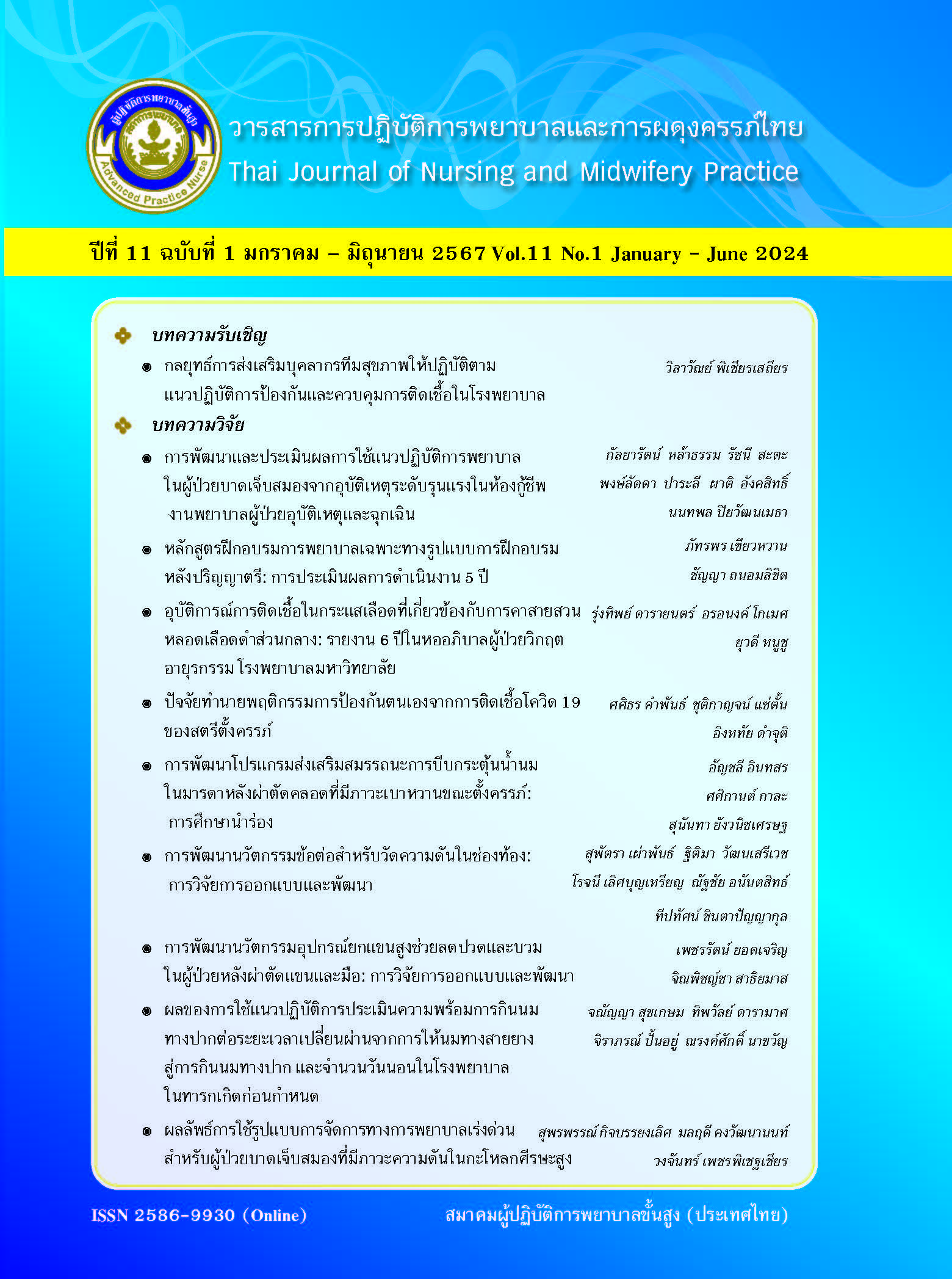Innovation Development of Port for Abdominal Pressure Measurement: Design and Development Research
Main Article Content
Abstract
This design and development research aimed to develop a port for intraabdominal pressure measurement, and evaluate the effectiveness of the port in measuring pressure in the abdomen. The research process comprised three phases: phase 1, identifying needs or problems from the workplace; phase 2, design and development of the port for measuring pressure in the abdomen based on the design thinking process; and phase 3, evaluating the effectiveness of the port in measuring pressure in the abdomen. The sample consisted of 33 pediatric critical care nurses and 10 pediatricians selected by convenience sampling. Instruments were the port for measuring pressure in the abdomen and a questionnaire to elicit the participants’ opinions regarding use of the port in measuring pressure in the abdomen. The data were analyzed using descriptive statistics. The results revealed that the port received a high mean score (M = 4.49; SD = 0.55), and a very high mean score (M = 4.80; SD = 0.42) for the effectiveness in measuring pressure in the abdomen from pediatric critical care nurses and pediatricians, respectively. The results of this study indicate that the port of pressure measurement in the abdomen was applicable for clinical practice and was safe.
Downloads
Article Details

This work is licensed under a Creative Commons Attribution-NonCommercial-NoDerivatives 4.0 International License.
References
Phaopant S. Nursing care in abdominal compartment syndrome. In: Sathavon D, Anantasit N, Aksin C, et al. editors. 4.0 Smart care for critically ill children. 1st ed. Bangkok: Beyond enterprise company limited; 2019. p 266-74. Thai.
Khuenkao P. Incidence, risk factors and outcomes of patient with intra- abdominal hypertension in PICU, Queen Sirikit National Institute of Child Health (QSNICH) in Thai context [dissertation]. Bangkok; 2017. 28 p. Thai.
Rogers WK, Garcia L. Intraabdominal hypertension, abdominal compartment syndrome, and the open abdomen. Chest. 2018; 153(1): 238-50. doi: 10.1016/j.chest.2017.07.023.
Junge N, Artmann A, Richter N, et al. Intraabdominal hypertension and compartment syndrome after pediatric liver transplantation: Incidence, risk factors and outcome. Children (Basel). 2022; 9(12): doi: 10.3390/children9121993.
Thabet FC, Bougmiza IM, Chehab MS, et al. Incidence, risk factors, and prognosis of intraabdominal hypertension in critically ill children: A prospective epidemiological study. J Intensive Care Med. 2016; 31(6): 403-8. doi: 10.1177/0885066615583645.
Ejike JC, Mathur M. Abdominal compartment syndrome. In: Nichols DG, Shaffner DH, editors. Rogers’ textbook of pediatric intensive care. 5th ed. China; 2016. p 1652-7.
Kirkpatrick AW, Roberts DJ, De Waele J, et al. Intra-abdominal hypertension and the abdominal compartment syndrome: Updated consensus definitions and clinical practice guidelines from the world society of the abdominal compartment syndrome. Intensive Care Med. 2013; 39(7): 1190-206. doi: 10.1007/s00134-013-2906-z.
Divarci E, Karapinar B, Yalaz M, et al. Incidence and prognosis of intraabdominal hypertension and abdominal compartment syndrome in children. J pediatr surg. 2016; 51(3): 503-7. doi: 10.1016/j.jpedsurg.2014.03.014.
Wiegandt P, Jack T, von Gise A, et al. Awareness and diagnosis for intra-abdominal hypertension (IAH) and abdominal compartment syndrome (ACS) in neonatal (NICU) and pediatric intensive care units (PICU) - a follow-up multicenter survey. BMC Pediatr. 2023; 23(1): 82. doi: 10.1186/s12887-023-03881-x.
Horoz OO, Yildizdas D, Asilioglu N, et al. The prevalance of and factors associated with intraabdominal hypertension on admission day in critically ill pediatric patients: A multicenter study. J Crit Care. 2015; 30(3): 584-8. doi: 10.1016/j.jcrc.2015.01.021.
Pinto GCC, Gaiga LC, de Moura MP, et al. Incidence and risk factors of abdominal compartment syndrome in pediatric oncology patients: a prospective cohort study. Eur J Pediatr. 2023; 182(8): 3611-7. doi: 10.1007/s00431-023-05013-0.
Harrell BR, Miller S. Abdominal compartment syndrome as a complication of fluid resuscitation. Nurs Clin North Am. 2017; 52(2): 331-8. doi: 10.1016/j.cnur.2017.01.010.
Popowicz P, Dayal N, Newman RK, et al. Abdominal compartment syndrome [Internet]. 2023 [cited 2024 Mar 15]. Available from: https://www.ncbi.nlm.nih.gov/books/NBK430932/
Gallagher JJ. Intra-abdominal pressure monitoring. In Verger JT, Lebet RM. (Eds.). AACN procedure manual for pediatric acute and critical care. London: Saunders Elsevier; 2008. p. 967-80.
De Waele JJ, Ejike JC, Leppäniemi A, et al. Intraabdominal hypertension and abdominal compartment syndrome in pancreatitis, paediatrics, and trauma. Anaesthesiol Intensive Ther. 2015; 47(3): 219-27. doi: 10.5603/AIT.a2015.0027.
Tansura S. Seansom D. Tiasawat U, et al. Comparison of bladder pressurement by use a ruler and transducer monitor. JHS. 2010; 19: 479-93. Thai.
di Natale A, Moehrlen U, Neeser HR, et al. Abdominal compartment syndrome and decompressive laparotomy in children: A 9-year
single-center experience. Pediatr Surg Int. 2020; 36(4): 513-21. doi: 10.1007/s00383-020-04632-0.
Kidjawan N. Design thinking process: New perspective in Thai healhcare system. TJNC. 2018; 33(1): 5-14. Thai.
Richey RC, Klein JD. Design and development research: Methods, strategies, and issues.Mahwah, NJ: Lawrence Erlbaum Associates, Publishers; 2007.
Thabet FC, Ejike JC. Intra-abdominal hypertension and abdominal compartment syndrome in pediatrics. A review. J crit care. 2017; 41: 275-82. doi: 10.1016/j.jcrc.2017.06.004.
Watkaew W. Pressure measurement instrument [Internet]. 2022 [cited 2024 Apr 6]. Available from: https://drive.google.com/file/d/10rpXIxwflTccJt909xUmYHzbnqR7HW7i/view. Thai.
Pongsukwetchakul T, Chiannilkulchai N. Development the clip lock for strap sterile operating microscope drape and evaluation of its effectiveness. Rama Nurs J. 2018; 4(2): 163-77. Thai.
Cox M. Design thinking in healthcare [Internet]. 2015 [cited 2024 Mar 15]. Available from: https://www.researchgate.net/publication/281408556_Design_Thinking_in_Healthcare
Gorad K, Prabhu V. A study of intra-abdominal pressure measurement using a new innovative technique with foley’s catheter. Med J DY Patil Univ. 2021; 14(5): 492-5. doi: 10.4103/mjdrdypu.mjdrdypu_544_20.


